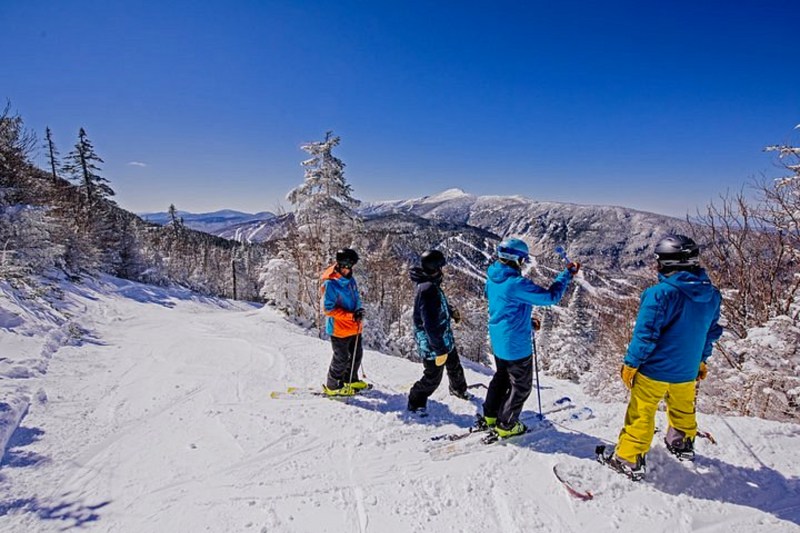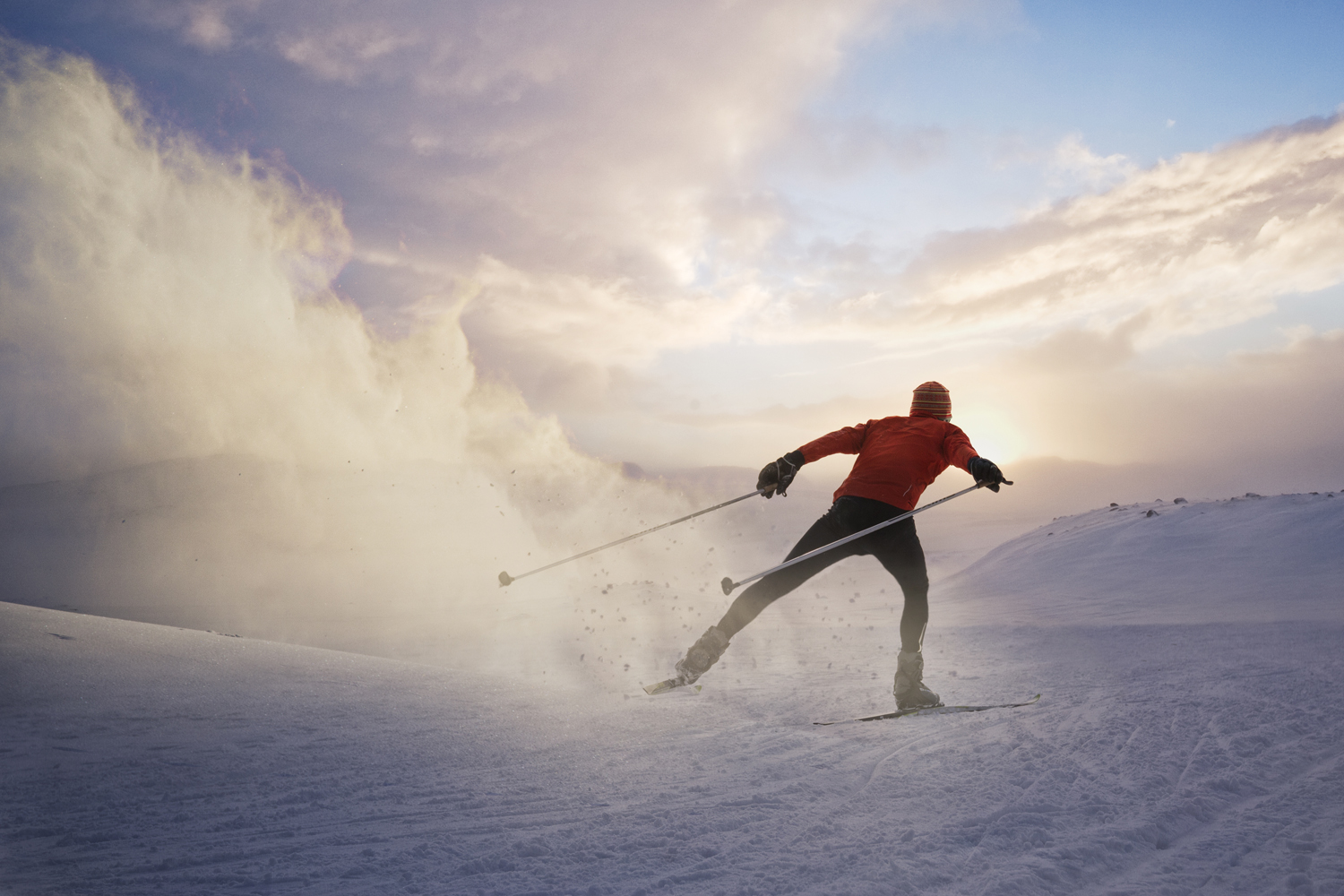
Your first time skiing can be a daunting experience. You’re standing in the snow, wearing a load of ski gear you’ve just bought, some ski boots that you’re trying to learn to walk in, and trying to work out which way up your ski map goes. You might be lost, but asking someone for help is not in the cards; you’ve already made that mistake and feel pretty confident that the answer wasn’t in a language you spoke.
To be clear, all the words were English, but the skier you spoke to was using their best skier slang. You’ve been told about a great dump he had this morning — more information than you needed — and been put off the park because it’s full of rats. You’re on the lookout for bluebirds, but presumably, they’ve all headed south for winter. And the word “brah” has cropped up more times than you’ve heard since college. Whether a secret code or the language of a culture, ski slang is everywhere around the ski resort. Our ski slang dictionary will give what you’ll need to get started when you start skiing this winter.

A – C
- Aprés — Aprés ski translates as “after ski” and means activities off the slopes. Aprés ski usually refers to the party scene of a resort, and ski towns live and die by their aprés reputations.
- Avi — Short for avalanche — hopefully not something you’ll have to worry about unless you’re going into the backcountry.
- Backcountry — The area outside the ski boundary that isn’t cleared of avi debris or danger and isn’t patrolled. Skiing here is undertaken at your own risk.
- Bail — To crash. This can be deliberate or accidental. It often happens in powder or off a jump or side hit.
- Bar — Sure, there are bars on the hill, but in ski terms, this is the bar on the chair lift. Usually shouted as “bar up” and “bar down,” you need to be ready not to get tangled up, get your skis caught on the bar, or have the bar bounce off your head on the way down.
- Base — Used for many things, from the pumping aprés music to the station at the bottom of the mountain and even the bottom of your skis. The resort base is the depth of snow coverage across the whole resort, with the base being the more packed-in, reliable snow.
- Bluebird — A day without a cloud in the sky and perfect visibility. Combine this with a fresh pow dump — see “dump” and “pow” further down — for the perfect day.
- Bro — Also, brah, dude, or any other phrase from The Big Lebowski or almost any teen stoner movie from the early 2000s. A term of endearment that is also used as punctuation.
- Butter — Not the type you have on your pancakes. Buttering is a trick where you lean your weight back onto the tail of your skis and press off the ends, either to initiate a trick or just for steeze points. See also steeze. You can either butter or nose butter off the tips.
- Button lift — Usually in the beginner areas or alongside the park, these lifts look like a button at the base and drag you up the hill.
- Bunny slope — The name given to the beginner slope.
- Carving — Not what you do at Thanksgiving. These are fast, clean turns using the edges of your skis.
- Champagne powder — Deep, fluffy snow that sprays up like a bottle of champagne when you put turns in. See also face shots.
- Corduroy — Not an alternative to ski pants; this refers to the look of a freshly groomed run.
D – G
- Death cookies — Chunks of ice — often dislodged by snow groomers — that can look invisible but cause you to bail hard.
- Double black diamond — The top level of the ski run. Go to any ski bar for your aprés and you’ll hear at least one person bragging about how they nailed their first double black diamond.
- Dump — Not what you need to do before you go skiing. A dump refers to snowfall. A big dump usually means deep powder. The first dump of the season is the first proper snowfall and often helps to create the base. An overnight dump followed by a bluebird day combine to create prime skiing conditions.
- Dust on crust — When the top layer freezes solid and you get a light snowfall, you get the illusion of a powder day. Then you head off-piste and find that you’ve got dust on crust: Not enough fresh snow for powder turns, but the base is too solid to get the edges in.
- Faceshot — When your turn fires up so much champagne powder that it hits you in the face. You must use this in context to avoid potential confusion and disgust. No, we will not explain why.
- First chair — A highly sought-after position in many resorts, the first chair means fresh tracks and untouched snow. The committed will be frying up their breakfast while in the lift line.
- First tracks — The first ski tracks on a groomer run or in untouched powder. Snow that isn’t churned up, perfectly flat groomers, or fresh champagne powder — it’s hard to beat.
- French fries — A lunch food that’s part of any good ski bum’s — see further down — staple diet, but also a term used to describe having your skis parallel to each other.
- Freshies — Similar to first tracks, but usually used to describe the first tracks put into powder.
- Glade — An area of open trees, usually found alongside, or in the middle of, a tree run. Many glades also make for the perfect secret stash — see further down.
- Gnarly — From surfing language, gnarly means anything from “awesome” to “I think I’ve just broken my leg.” Context is everything.
- Groomer — Known in Europe as the piste, these are the groomed runs in the resort marked out by your resort map.

J – P
- Jerry — Also referred to as gapers, Jerries show a complete lack of understanding not just of skiing but of life itself. Skiing across a tarmac road, wearing ski goggles upside-down, wearing a backward bicycle helmet, and the crossed-ski carry are all examples of Jerry-dom in action.
- Liftie — The kings and queens of swinging chairs. These guys and gals exhibit their ability to stay upbeat in sub-zero conditions as they sweep, swing, and send you on your way, all to the backdrop of their chosen season playlist.
- Magic carpet — Not so much flying as a conveyor belt. Often found next to the bunny slope, the magic carpet carries you uphill.
- Off-piste — The gaps between the groomers. Off-piste usually refers to inbound skiing that isn’t groomed.
- Park rat — Knee-length hoodies, a laid-back approach, and some of the steeziest tricks around. Park rats spend their days hitting jumps and sliding rails, no matter how much powder there is elsewhere in the resort.
- Parallel turn — The aim of all beginner skiers is a parallel turn where you turn both your skis at once, leading into carved turns and getting you carrying more speed.
- Pizza — Skiing for beginners 101, the pizza shape — also known as the snowplow — helps to control your speed and start your turns.
- Pow — Short for powder.
- Pow hound — Someone who hunts out powder runs and is all about the deep runs. This skier will be sniffing out new lines several days after a dump, exploring the bounds of the resort for that perfect turn.

S – Y
- Send — Respect the send. This is the art of no-holds-barred skiing, firing off jumps into steep runs and glades, often ending in a yard sale.
- Sendy/sender — Someone is sendy, or a sender, if they live and die by the art of going big. There’s a fine line between being sendy and being out of control — ride that line!
- Side hit — A jump or a kicker at the side of the groomer. These are usually sculpted by constant riding rather than being built. Park rats who expand their boundaries love a side hit.
- Snow groomer — The machines that groom the pistes in the resort. You can often see their lights on the hill while you’re drinking in the bar.
- Ski bum — Someone who lives for the ski life. This person will call in sick — or even quit their job — to feed their habit. They sofa surf, live the van life, crash in hostels and basements, wash their socks in a sink, and stuff their pockets with sauce packets in the diner — anything to save a few bucks that can get them skiing another day.
- Stash — A secret pocket of powder — often a glade — that you can lap all day with fresh tracks.
- Steeze — Perhaps the ultimate skiing slang term, steeze is someone’s style — both on and off the skis. If you’ve got steeze, you’re never short of a crew.
- Stomp — To land a big jump in style.
- Straightlining — Pointing down the hill and skiing as fast as possible. Useful for riding fast and crossing a flat spot.
- Switch — Riding backward, usually used for landing 180 jumps or hitting jumps backward.
- Tracked out — When you’re out of fresh lines when a powder run has been ridden, you have to ride other people’s tracks instead of finding fresh powder.
- Twins — Twin-tip skis rather than a set of identical siblings. These skis can be ridden forwards and backward, ideal for park rats who like to ride switch. All of this ski slang is coming together, see?
- White room — When the visibility is so bad that you can’t tell which way is up, everything looks white, and you have to follow piste markers down the groomer.
- Wipeout — Like a bail, but far more dramatic.
- Yard sale — When everything goes everywhere. After a bail or, more usually, a wipeout, you might have your skis on either side of the groomer, poles halfway up a slope elsewhere, goggles bouncing downhill, and even the ski helmet rolling off your head. Everything must go.

Slang for snowboarders
While most of the terms in our ski slang dictionary can also apply to snowboarders, there are a few terms that are specific to snowboarding, so here is a supplement to our ski slang dictionary for the snowboarding public.
- Brain bucket: A helmet.
- Half-pipe: A U-shaped structure made of snow for advanced trick riding.
- Jib: Something you slide your snowboard on that isn’t snow, rails, boxes, downed trees, etc.
- Jibbing: The term for sliding on a jib.
- Kicker (or booter): A jump.
- Riding/Rider: A snowboarder
- Shredding: A term used when you are riding as fast as you can, hitting the hill hard, and having the time of your life.
- Terrain park (also called park or freestyle park): A part of the ski resort with features like jumps and rails for doing tricks.




